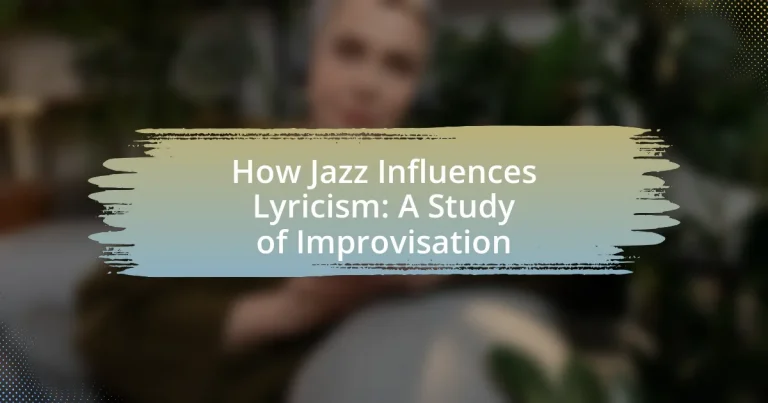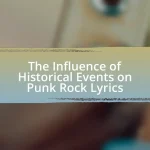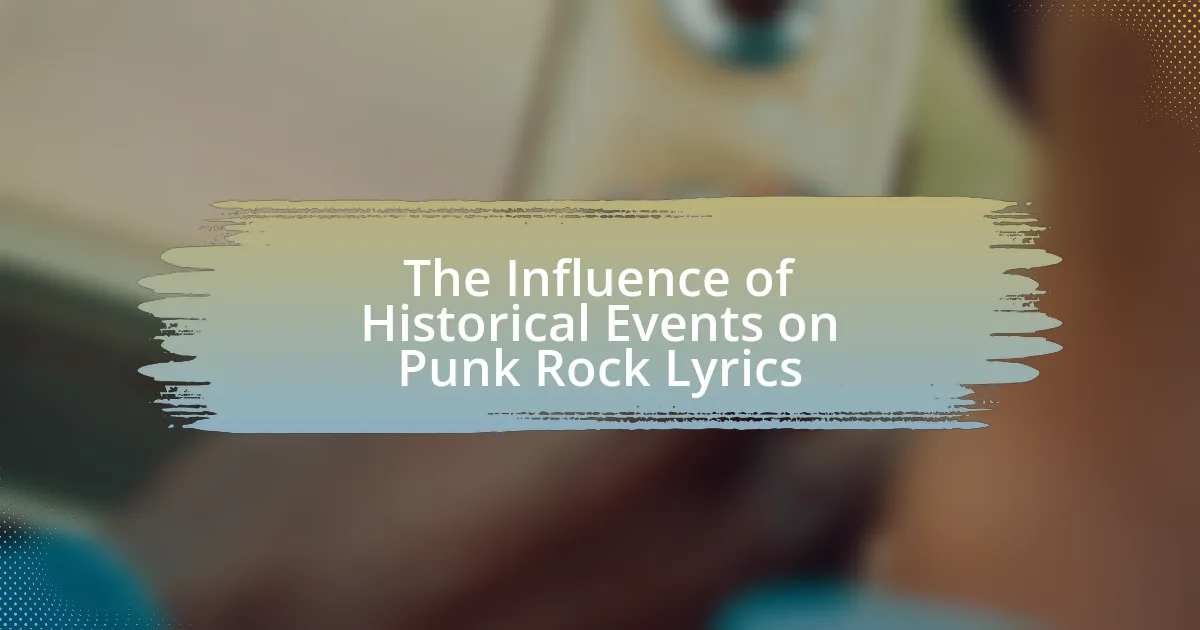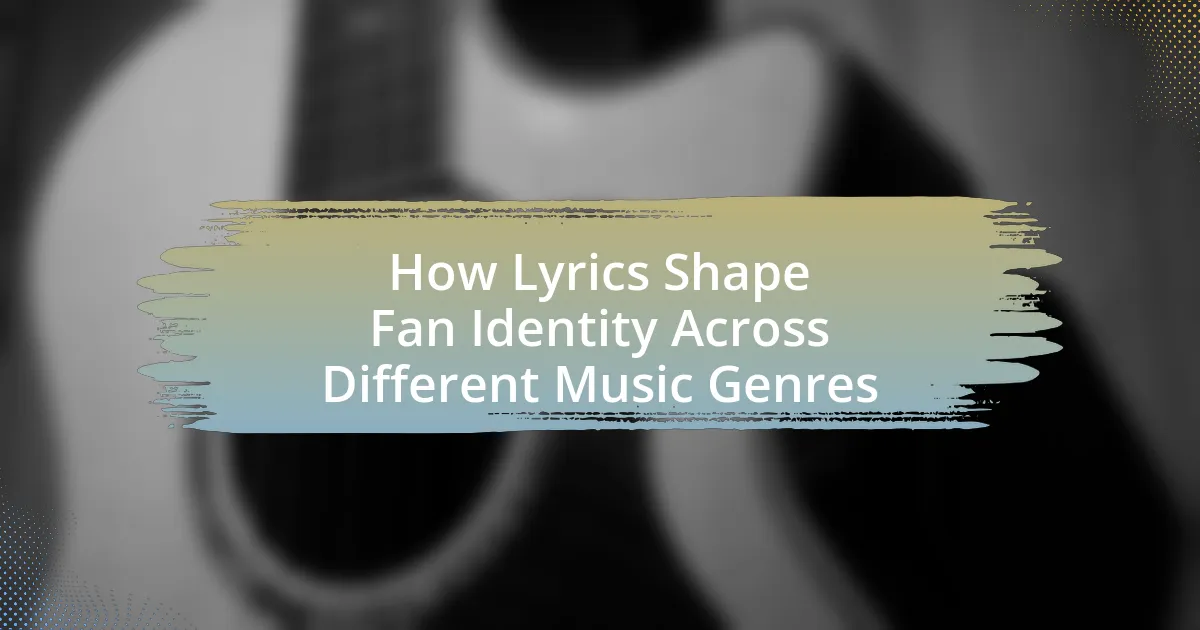The article examines how jazz influences lyricism, particularly through the elements of improvisation, rhythm, and emotional expression. It highlights the significance of improvisation in fostering creativity and spontaneity in lyrical composition, as well as the role of rhythm in shaping the flow and delivery of lyrics. Key techniques borrowed from jazz, such as syncopation and melodic phrasing, are discussed, along with the historical connections between jazz and lyricism that have evolved over time. The article also explores how cultural movements have impacted lyrical themes, emphasizing the reflection of social and political issues in jazz-inspired lyrics. Additionally, practical tips for lyricists on incorporating jazz elements into their work are provided, along with resources for further exploration of the relationship between jazz and lyricism.
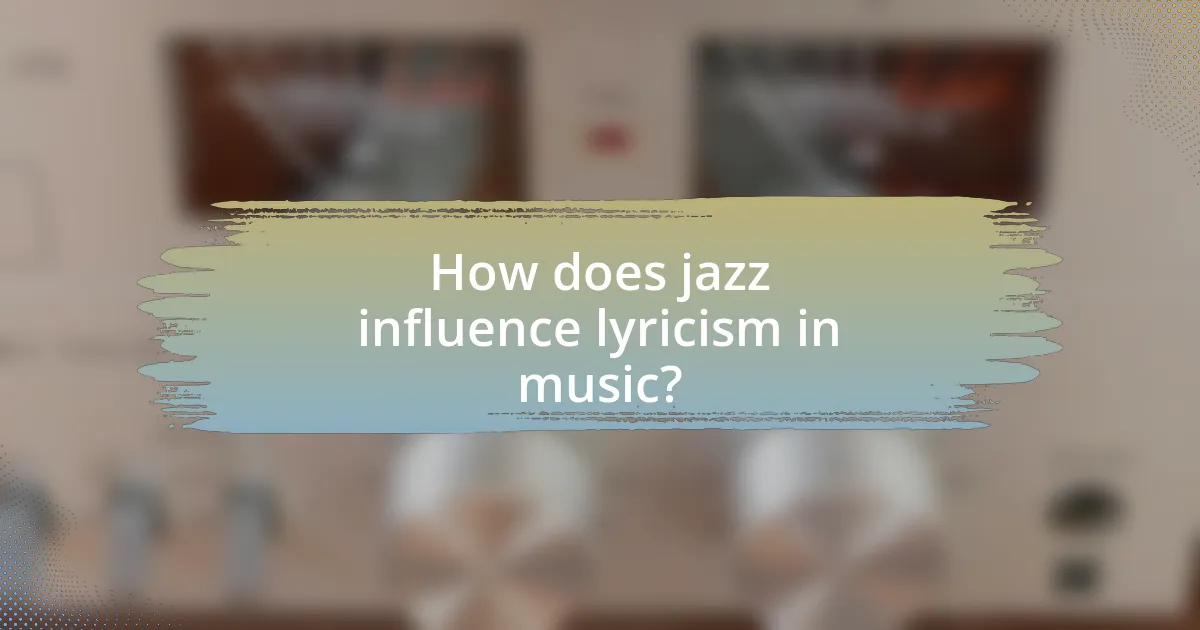
How does jazz influence lyricism in music?
Jazz significantly influences lyricism in music by introducing elements of improvisation, rhythm, and emotional expression. The improvisational nature of jazz encourages lyricists to experiment with phrasing and structure, allowing for more fluid and spontaneous lyrical compositions. This influence is evident in genres such as hip-hop and R&B, where artists often incorporate jazz-inspired rhythms and melodic lines into their lyrics. For instance, the use of syncopation and varied meter in jazz can lead to innovative lyrical patterns that enhance storytelling and emotional depth. Additionally, jazz’s focus on personal expression and storytelling has inspired lyricists to explore complex themes and emotions, resulting in more nuanced and impactful lyrics.
What are the key elements of jazz that impact lyricism?
The key elements of jazz that impact lyricism include improvisation, rhythm, and harmony. Improvisation allows lyricists to explore spontaneous expression, mirroring the fluidity of jazz performances, which often feature unexpected melodic and rhythmic shifts. Rhythm in jazz, characterized by syncopation and swing, influences the pacing and flow of lyrics, enabling a dynamic interplay between words and music. Harmony, with its complex chord progressions, provides a rich backdrop for lyrical themes, enhancing emotional depth and resonance. These elements collectively shape the way lyrics are crafted and delivered in jazz-influenced music, fostering a unique narrative style that reflects the genre’s improvisational roots.
How does improvisation in jazz shape lyrical creativity?
Improvisation in jazz significantly enhances lyrical creativity by encouraging spontaneity and emotional expression. This dynamic process allows musicians to explore new ideas and themes in real-time, leading to innovative lyrical content that reflects personal experiences and emotions. For instance, artists like Billie Holiday and Charles Mingus utilized improvisational techniques to convey deep emotional narratives in their lyrics, demonstrating how the fluidity of jazz can inspire unique storytelling. The interplay between melody and lyrics in jazz improvisation fosters a creative environment where artists can experiment with language, rhythm, and structure, ultimately enriching the lyrical landscape of the genre.
What role does rhythm play in the relationship between jazz and lyrics?
Rhythm serves as a foundational element in the relationship between jazz and lyrics, shaping the flow and emotional impact of the words. In jazz, rhythm provides a dynamic framework that allows for syncopation and improvisation, which directly influences how lyrics are delivered and interpreted. For instance, the use of swing rhythms in jazz can enhance the expressiveness of lyrics, allowing vocalists to play with timing and phrasing, creating a conversational quality that resonates with listeners. This interplay is evident in the works of artists like Billie Holiday and Ella Fitzgerald, who skillfully adapted their vocal rhythms to match the intricate patterns of jazz instrumentation, thereby enriching the lyrical narrative.
Why is improvisation significant in both jazz and lyricism?
Improvisation is significant in both jazz and lyricism because it fosters creativity and spontaneity, allowing artists to express their emotions and ideas in real-time. In jazz, musicians often create melodies and harmonies on the spot, which enhances the music’s dynamic quality and engages the audience. Similarly, in lyricism, artists frequently employ improvisational techniques, such as freestyling, to generate unique and impactful verses that resonate with listeners. This practice not only showcases the artist’s skill but also reflects the cultural and emotional context of the moment, making the performance more authentic and relatable. Historical examples include jazz legends like Miles Davis, who emphasized improvisation as a core element of his music, and contemporary lyricists like Eminem, who are known for their ability to improvise complex rhymes and rhythms, demonstrating the enduring significance of improvisation in both art forms.
How does improvisation enhance emotional expression in lyrics?
Improvisation enhances emotional expression in lyrics by allowing artists to convey genuine feelings spontaneously, resulting in more authentic and relatable content. This spontaneous creation process enables lyricists to tap into their immediate emotional states, leading to lyrics that resonate deeply with listeners. Research indicates that improvisational techniques, often used in jazz, encourage artists to explore varied emotional landscapes, thus enriching the lyrical narrative. For instance, studies have shown that musicians who engage in improvisation report heightened emotional awareness, which translates into more impactful and evocative lyrics.
What techniques do lyricists borrow from jazz improvisation?
Lyricists borrow several techniques from jazz improvisation, including spontaneous creation, rhythmic variation, and melodic phrasing. Spontaneous creation allows lyricists to generate lyrics on the spot, mirroring jazz musicians’ ability to improvise melodies and solos during performances. Rhythmic variation involves altering the flow and timing of lyrics to create a dynamic and engaging delivery, similar to how jazz artists manipulate tempo and syncopation. Melodic phrasing enables lyricists to craft lines that flow musically, akin to the way jazz musicians develop motifs and themes within their improvisations. These techniques enhance the expressiveness and creativity of lyrical compositions, reflecting the improvisational spirit of jazz.
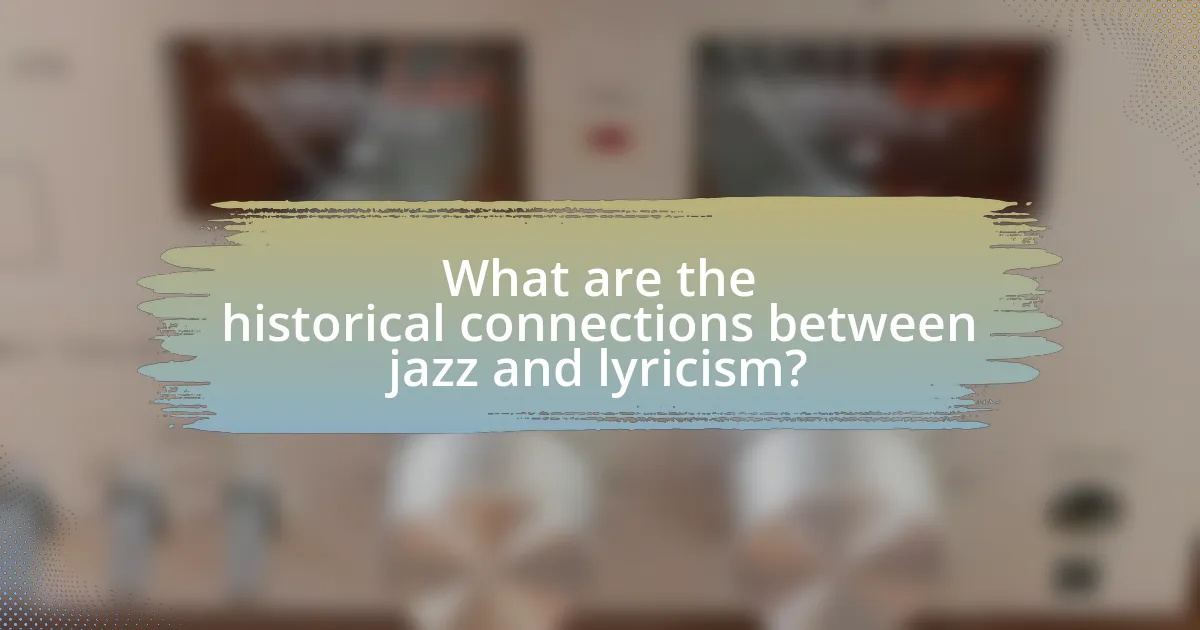
What are the historical connections between jazz and lyricism?
Jazz and lyricism are historically connected through the evolution of musical expression and the integration of improvisation in both forms. In the early 20th century, jazz emerged as a distinct genre, characterized by its improvisational nature, which allowed musicians to express emotions and narratives in real-time. This improvisation influenced lyricism, as songwriters began to adopt a more conversational and spontaneous style in their lyrics, mirroring the fluidity of jazz performance.
Notably, artists like Louis Armstrong and Billie Holiday incorporated storytelling into their vocal improvisations, blending melody and lyrics in a way that emphasized emotional depth. The Harlem Renaissance further solidified this connection, as poets and lyricists drew inspiration from jazz rhythms and themes, creating a rich interplay between spoken word and musical expression. This historical synergy has continued to shape contemporary music, where jazz elements are often infused into various lyrical styles, demonstrating the lasting impact of jazz on the art of lyricism.
How did jazz evolve to influence modern lyricism?
Jazz evolved to influence modern lyricism primarily through its emphasis on improvisation and emotional expression. The improvisational nature of jazz allowed artists to explore personal narratives and complex themes, which modern lyricists have adopted to create more dynamic and relatable lyrics. For instance, the use of syncopation and varied rhythms in jazz has inspired contemporary songwriters to experiment with meter and phrasing, leading to innovative lyrical structures. Additionally, jazz’s roots in African American culture and its focus on storytelling have encouraged modern lyricists to address social issues and personal experiences in their work, reflecting the same depth and authenticity found in jazz compositions. This evolution is evident in genres such as hip-hop and R&B, where artists frequently incorporate jazz elements into their lyrics and musical arrangements, showcasing the lasting impact of jazz on modern lyricism.
What notable artists exemplify the fusion of jazz and lyrical innovation?
Notable artists who exemplify the fusion of jazz and lyrical innovation include Gil Scott-Heron and Esperanza Spalding. Gil Scott-Heron is recognized for his spoken word style that blends jazz instrumentation with socially conscious lyrics, particularly in works like “The Revolution Will Not Be Televised.” Esperanza Spalding, a contemporary artist, combines jazz with various genres and innovative lyrical themes, as seen in her album “Emily’s D+Evolution,” which showcases her unique approach to storytelling through music. Both artists illustrate how jazz influences lyrical creativity and expression.
How have cultural movements shaped the relationship between jazz and lyrics?
Cultural movements have significantly shaped the relationship between jazz and lyrics by influencing thematic content and stylistic expression. For instance, the Harlem Renaissance in the 1920s fostered a rich environment for African American artists, leading to the incorporation of social and political themes in jazz lyrics, as seen in the works of artists like Billie Holiday and Langston Hughes. Additionally, the Civil Rights Movement in the 1960s prompted jazz musicians to address issues of racial injustice and equality in their lyrics, exemplified by songs like “Strange Fruit.” These movements not only provided a platform for lyrical innovation but also encouraged a fusion of spoken word and musical improvisation, enhancing the overall narrative quality of jazz.
What are the common themes found in jazz-influenced lyrics?
Common themes found in jazz-influenced lyrics include love, longing, social issues, and the celebration of life. Love is often depicted through emotional expressions and complex relationships, reflecting the improvisational nature of jazz. Longing frequently appears in the context of desire and nostalgia, capturing the essence of yearning that is prevalent in many jazz compositions. Social issues, such as race and inequality, are also prominent, as jazz has historically been a voice for marginalized communities, addressing struggles and resilience. Lastly, the celebration of life is expressed through themes of joy, freedom, and spontaneity, mirroring the improvisational spirit of jazz music itself. These themes collectively illustrate the depth and richness of jazz-influenced lyricism.
How do jazz lyrics reflect social and political issues?
Jazz lyrics reflect social and political issues by addressing themes of racial inequality, civil rights, and personal struggles. For instance, songs like “Strange Fruit,” performed by Billie Holiday, poignantly highlight the horrors of lynching and racism in America, serving as a powerful protest against racial violence. Additionally, jazz musicians often used their lyrics to comment on the socio-political climate of their times, such as the Harlem Renaissance, which emphasized African American culture and identity. This connection between jazz lyrics and social commentary illustrates how the genre has historically provided a voice for marginalized communities, making it a significant medium for expressing dissent and advocating for change.
What storytelling techniques are prevalent in jazz-inspired lyricism?
Jazz-inspired lyricism frequently employs techniques such as improvisation, vivid imagery, and emotional expression. Improvisation allows lyricists to create spontaneous narratives that reflect real-time emotions and experiences, mirroring the improvisational nature of jazz music itself. Vivid imagery is utilized to paint detailed scenes and evoke sensory experiences, engaging listeners and enhancing the storytelling aspect. Emotional expression is central to jazz-inspired lyrics, as artists convey deep feelings and personal stories, often drawing from their own life experiences, which resonates with audiences. These techniques collectively create a rich, dynamic storytelling experience that is characteristic of jazz-influenced lyricism.
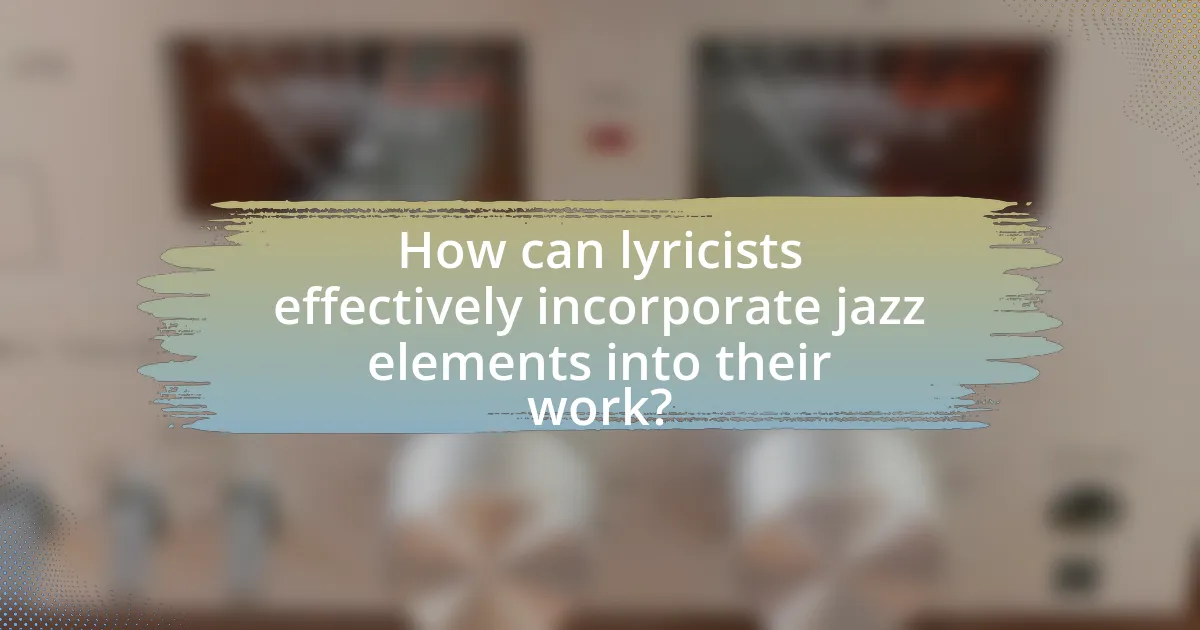
How can lyricists effectively incorporate jazz elements into their work?
Lyricists can effectively incorporate jazz elements into their work by utilizing improvisation, syncopation, and rich imagery. Improvisation allows lyricists to create spontaneous and fluid lines that mirror the free-form nature of jazz music, enhancing emotional expression. Syncopation, a rhythmic technique prevalent in jazz, can be applied to lyrics to create unexpected accents and a dynamic flow, making the words more engaging. Additionally, employing vivid imagery and metaphor, often found in jazz lyrics, can evoke strong emotions and paint a picture that resonates with listeners. These techniques not only enrich the lyrical content but also create a deeper connection to the jazz tradition, as seen in the works of artists like Billie Holiday and Gil Scott-Heron, who seamlessly blended lyrical storytelling with jazz influences.
What practical tips can help lyricists draw inspiration from jazz?
Lyricists can draw inspiration from jazz by embracing improvisation, which is a core element of jazz music. Engaging in free-form writing sessions allows lyricists to explore spontaneous ideas and emotions, mirroring the improvisational solos of jazz musicians. Additionally, studying jazz lyrics and their rhythmic structures can enhance a lyricist’s understanding of flow and phrasing, as seen in the works of artists like Billie Holiday and Ella Fitzgerald, who often played with timing and melody. Listening to various jazz styles, such as bebop or smooth jazz, can also provide diverse emotional palettes and thematic material for lyrics, as these genres evoke different moods and narratives.
How can studying jazz musicians improve a lyricist’s craft?
Studying jazz musicians can significantly enhance a lyricist’s craft by providing insights into improvisation, rhythm, and emotional expression. Jazz musicians often utilize improvisation, which encourages lyricists to experiment with spontaneous ideas and develop a more fluid writing style. This practice can lead to more dynamic and engaging lyrics, as it fosters creativity and adaptability in the writing process. Additionally, jazz emphasizes complex rhythms and syncopation, which can inspire lyricists to play with meter and phrasing, resulting in more innovative lyrical structures. The emotional depth found in jazz performances also teaches lyricists to convey feelings authentically, enriching their storytelling capabilities.
What exercises can lyricists practice to enhance their improvisational skills?
Lyricists can enhance their improvisational skills by practicing exercises such as free writing, call and response, and word association. Free writing involves setting a timer and writing continuously without self-editing, which fosters spontaneity and creativity. Call and response exercises, often used in jazz, encourage lyricists to respond to musical cues or phrases, enhancing their ability to think quickly and adapt. Word association games help lyricists build a mental database of rhymes and themes, allowing for quicker lyrical responses. These exercises are supported by the improvisational techniques used in jazz, where musicians often rely on quick thinking and adaptability to create spontaneous performances.
What resources are available for exploring jazz and lyricism?
Books, online courses, and music archives are valuable resources for exploring jazz and lyricism. Notable books include “The Jazz Standards” by Ted Gioia, which provides insights into jazz compositions and their lyrical elements, and “How to Write a Song: The Complete Guide” by Rikky Rooksby, which covers songwriting techniques influenced by jazz. Online platforms like Coursera and MasterClass offer courses on jazz music and songwriting, featuring lessons from renowned artists. Additionally, music archives such as the Smithsonian Jazz Collection provide access to historical recordings and documents that illustrate the relationship between jazz and lyricism, showcasing the improvisational nature of both forms.
Which books and documentaries provide insights into jazz’s influence on lyrics?
Books such as “The Jazz Standards: A Guide for Performers” by Ted Gioia and “The Language of Jazz: A Study of Improvisation” by David Baker provide insights into jazz’s influence on lyrics by analyzing the interplay between musical improvisation and lyrical expression. Documentaries like “Jazz: A Film by Ken Burns” explore the historical context and cultural impact of jazz, highlighting how its improvisational nature has shaped lyrical themes and styles across various genres. These sources collectively illustrate the profound connection between jazz music and lyrical creativity, emphasizing the role of improvisation in shaping modern songwriting.
How can online platforms facilitate learning about jazz and lyricism?
Online platforms can facilitate learning about jazz and lyricism by providing access to a wide range of educational resources, including video tutorials, interactive courses, and forums for discussion. These platforms, such as YouTube, Coursera, and specialized music education sites, offer structured lessons that cover fundamental concepts of jazz theory, improvisation techniques, and lyrical composition. For instance, platforms like Jazz at Lincoln Center provide online masterclasses featuring renowned musicians, which allow learners to observe and analyze professional improvisation and lyricism in real-time. Additionally, online communities enable collaboration and feedback, fostering a supportive environment for aspiring artists to share their work and receive constructive criticism. This accessibility and interactivity enhance the learning experience, making it easier for individuals to grasp complex jazz concepts and apply them to their own lyrical creations.
